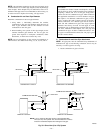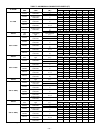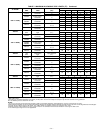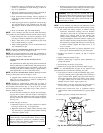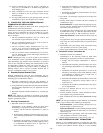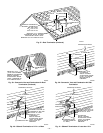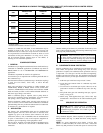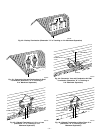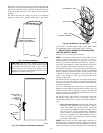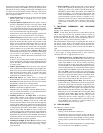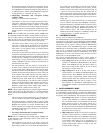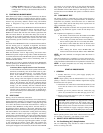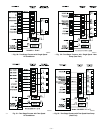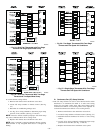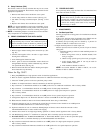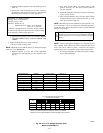
thermostat is still calling for gas heating. The amber LED light will
flash code 12 during the 90-second period, after which the LED
will be ON continuous, as long as no faults are detected. After the
90-second period, the furnace will respond to the thermostat
normally.
The blower door must be installed for power to be conducted
through the blower door interlock switch ILK to the furnace
control CPU, transformer TRAN, inducer motor IDM, blower
motor BLWM, hot-surface igniter HSI, and gas valve GV.
I. SINGLE-STAGE THERMOSTAT AND TWO-STAGE
HEATING (ADAPTIVE MODE)
See Fig. 28 or 57 for thermostat connections
NOTE: Low-heat-only switch, SW1-2, selects either the low-
heat-only operation mode when ON, (see item 2. below) or
adaptive heating mode when OFF, in response to a call for heat.
(See Fig. 32.) When the W2 thermostat terminal is energized, it
will always cause high-heat operation when the R to W circuit is
closed, regardless of the setting of the low-heat only switch.
This furnace can operate as a two-stage furnace with a single-stage
thermostat because furnace control CPU includes a programmed
adaptive sequence of controlled operation, which selects low-heat
or high-heat operation. This selection is based upon the stored
history of the length of previous gas heating periods of the
single-stage thermostat.
The furnace will start up in either low- or high-heat. If the furnace
starts up in low-heat, the furnace control CPU determines the
low-heat on time (from 0 to 16 minutes) which is permitted before
switching to high-heat.
If power is interrupted, the stored history is erased. When this
happens, the control CPU will initially select low-heat for up to 16
minutes and then switch to high-heat, as long as the thermostat
continues to call for heat. Subsequent selection is based on stored
history of thermostat cycle times.
The wall thermostat ″calls for heat″, closing the R to W circuit.
The furnace control CPU performs a self-check, verifies the
low-heat and high-heat pressure switch contacts LPS and HPS are
open.
1. Inducer Prepurge Period-The furnace control CPU turns
on inducer motor IDM and slowly increases the inducer
motor speed. When the low-heat pressure switch LPS
closes, inducer motor RPM is noted by the furnace control
CPU, and a 25-sec. prepurge period begins. The RPM is
used to evaluate vent system resistance. This evaluation is
then used to determine the required RPM necessary to
operate the inducer motor during the low-heat prepurge
period and low-heat mode.
NOTE: The heat cycle can start in either high-or low-heat. If a
high-heat cycle is initiated, the furnace control CPU will de-
energize the high-heat pressure switch relay HPSR to close the NC
contact and continues to increase the inducer motor speed after the
CAUTION: Unit must not be installed, operated, and
then turned and left off in an unoccupied structure during
cold weather when temperature drops to 32°F or below
unless drain trap and drain line have adequate freeze
protection. See Service and Maintenance Instructions for
winterizing procedure. (See Fig. 47.)
A93058
Fig. 47—Freeze Protection
32°F MINIMUM INSTALLED
AMBIENT OR FREEZE
PROTECTION REQUIRED
Fig. 48—Example of Field Drain Attachment
A94054
OPEN STAND
PIPE FOR
A/C OR
HUMIDIFIER
DRAIN
TEE
TO OPEN
DRAIN
Fig. 49—Condensate Trap Heat Tape
A93036
CONDENSATE TRAP
WIRE TIE(S)
HEAT TAPE
(3 WRAPS MINIMUM)
—33—



